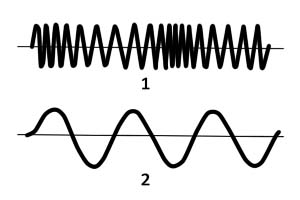In a transverse wave, the crest and troughs are the locations of maximum displacement up or down.
The crest is the highest point of the wave.
The trough is the lowest point of the wave.
The distance between two successive wave crests is known as the Wavelength. It is the distance of one complete wave cycle. For example, the distance from crest to crest or trough to trough would be 1 wavelength.
The distance from the midpoint or rest position of the wave to either the crest or trough of the wave is known as amplitude. It is the measurement of maximum displacement.
In a longitudinal wave, areas of maximum displacement are known as compressions and rarefactions. The stronger the wave, the more compressed and spread out the wave medium becomes.

1. Longitudinal Wave
2. Transverse Wave
We can calculate the velocity of a wave. First, we need to know the wavelength or the length of one complete wave cycle. This could be measured crest to crest or trough to trough. The second aspect we need is the wave frequency or the number of waves or vibrations produced per second. The frequency is measured in Hertz and the wavelength is measured in meters.
The equation for calculating the velocity of a wave is: Velocity (v) = Wavelength (λ) x Frequency (f)
Or, v = λ x f
This equation works for any waveform, water, sound or radio waves.
For example: A wave has a wavelength of 5 meters and a frequency of 10 Hz. What is its velocity?
Velocity = 5 x 10 = 50 meters per second
A single pulse caused by a single disturbance or vibration is called a wave pulse. A constant vibration would then produce a series of continuous pulses referred to as a wave.
The time for one complete cycle or vibration is called the period. The symbol for the period is T.
The number of cycles or vibrations that occur in one second is known as frequency. The units of frequency are Hertz (Hz).
1 Hz is one vibration in one second. The symbol for frequency is f.
Period and frequency are related by the following equation: T = 1/f